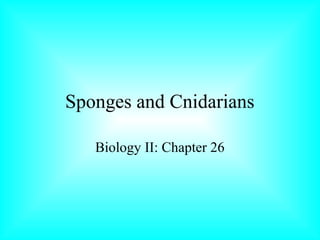
sponges and cnidarians, biology
- 1. Sponges and Cnidarians Biology II: Chapter 26
- 2. The Animal Kingdom • Multicellular • Eukaryotic • Heterotrophs • Cells lack cell walls • 95% are invertebrates
- 3. What Animals Do to Survive • Feeding • Respiration • Circulation • Excretion • Response • Movement • Reproduction
- 4. Trends in Animal Evolution • Cell specialization and levels of organization • Early development • Body symmetry • Cephalization • Body cavity formation
- 5. SPONGES
- 6. Sponges • Phylum Porifera • Have tiny openings, or pores, all over their bodies • Sessile: they live their entire life attached to a single spot • They are animals! Why…?
- 7. Sponges are Animals!!! • Multicellular • Heterotrophic • No cell walls • Contain a few specialized cells
- 8. Form and Function in Sponges • Have nothing resembling a mouth or gut • Have no tissues or organ systems • Simple functions are carried out by a few specialized cells
- 9. Asymmetrical • Have no front or back ends, no left and right sides • A large, cylindrical water pump • The body forms a wall around a large central cavity through which water flows continually
- 10. Choanocytes • Specialized cells that use flagella to move a steady current of water through the sponge • Filters several thousand liters/day
- 11. Osculum • A large hole at the top of the sponge, through which water exits • The movement of water provides a simple mechanism for feeding, respiration, circulation and excretion
- 12. Simple Skeleton • Spicule: a spike-shaped structure made of chalk-like calcium carbonate or glasslike silica in hard sponges • Archaeocytes: specialized cells that make spicules
- 13. Feeding • Filter feeders • Sift microscopic food from the water • Particles are engulfed by choanocytes that line the body cavity
- 14. Respiration, Circulation, & Excretion • Rely on the movement of water through their bodies to carry out body functions • As water moves through the cavity: • Oxygen dissolved in the water diffuses into the surrounding cells • Carbon dioxide and other wastes, diffuse into the water and are carried away
- 15. Response • No nervous system • Many sponges protect themselves by producing toxins that make them unpalatable or poisonous to potential predators
- 16. Reproduction • Sexually or asexually • A single spore forms both eggs and sperm; usually at different times
- 17. Sexual Reproduction • Internal fertilization: Eggs are fertilized inside the sponge’s body • Sperm are released from one sponge and carried by currents to the pores of another sponge
- 18. Asexual Reproduction • Budding • Gemmules: groups of archaeocytes surrounded by spicules
- 19. Ecology of Sponges • Ideal habitats for marine animals such as snails, sea stars, sea cucumbers, and shrimp • Mutually beneficial relationships with bacteria, algae and plant-like protists – Many are green due to these organisms living in their tissues
- 20. Ecology of Sponges • Attached to the seafloor and may receive little sunlight • Some have spicules that look like cross- shaped antennae • Like a lens or magnifying glass, they focus and direct incoming sunlight
- 21. CNIDARIANS
- 22. Cnidarians • Phylum Cnidaria • Hydras, jellies, sea anemones, and corals • Soft-bodied • Carnivorous • Stinging tentacles arranged in circles around their mouths • Simplest animals to have body symmetry and specialized cells
- 23. Cnidocytes • Stinging cells that are located on their tentacles • Used for defense and to capture prey
- 24. Nematocyst • A poison-filled, stinging structure that contains a tightly coiled dart • Found within cnidocytes
- 25. Form and Function in Cnidarians • Only a few cells thick • Simple body systems • Most of their responses to the environment are carried out by specialized cells and tissues
- 26. Radially Symmetrical • Central mouth surrounded by numerous tentacles that extend outward from the body • Life cycles includes a polyp and a medusa stage
- 27. Body Plan • Polyp: cylindrical body with arm-like tentacles; mouth points upward • Medusa: motile, bell- shaped body; mouth on the bottom
- 28. Feeding • Polyps and medusas have a body wall that surrounds an internal space: the gastrovascular cavity • Gastrovascular cavity: a digestive chamber with one opening – Food enters and wastes leave the body
- 29. Respiration, Circulation, & Excretion • Following digestion, nutrients are usually transported throughout the body by diffusion • Respire and eliminate wastes by diffusion through body walls
- 30. Response • Specialized sensory cells are used to gather information from the environment • Nerve net: loosely organized network of nerve cells that together allow cnidarians to detect stimuli – Distributed uniformly throughout the body in most species – In some species it is concentrated around the mouth or in rings around the body
- 31. Response • Statocysts: groups of sensory cells that help determine the direction of gravity • Ocelli: eyespots made of cells that detect light
- 32. Movement • Hydrostatic skeleton: a layer of circular muscles and a layer of longitudinal muscles that enable cnidarians to move
- 33. Reproduction: Sexually and Asexually • Polyps can reproduce asexually by budding • External sexual reproduction – The sexes are separate-each individual is either male or female – Both egg and sperm are released into the water
- 34. Groups of Cnidarians • Jellies (formerly jellyfishes) • Hydras and their relatives • Sea anemones • Corals
- 35. Ecology of Corals • The worldwide distribution is determined by: – Temperature – Water depth – Light intensity • Many suffer from human activity • Coral bleaching has become common • Global warming may add to the problem